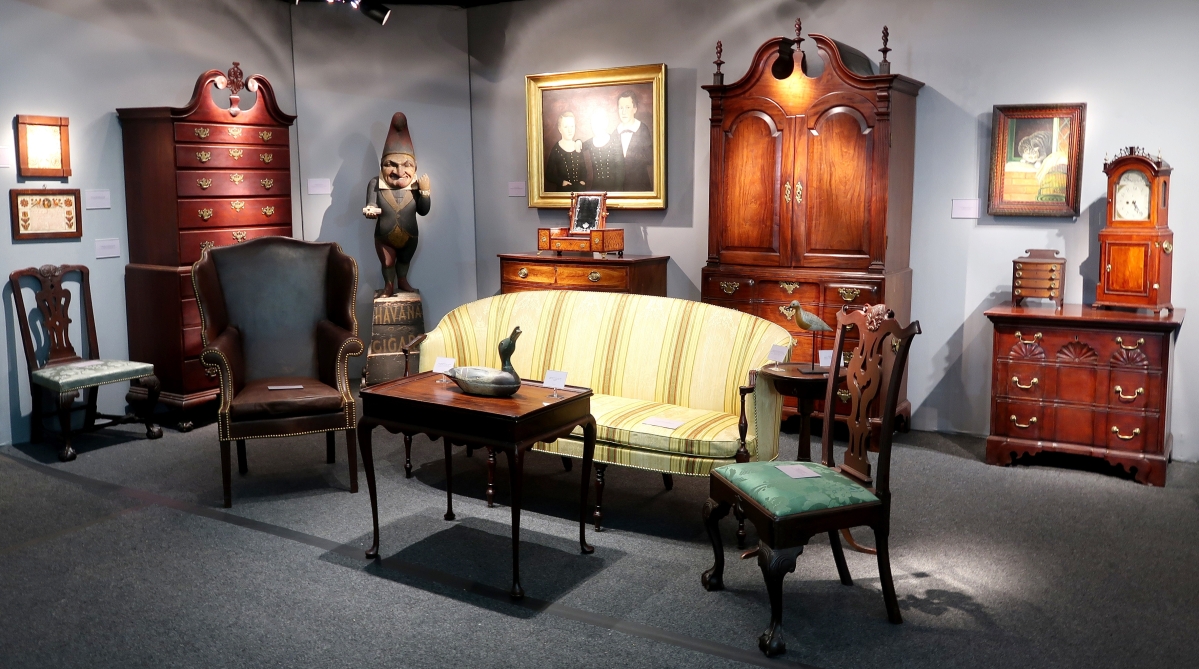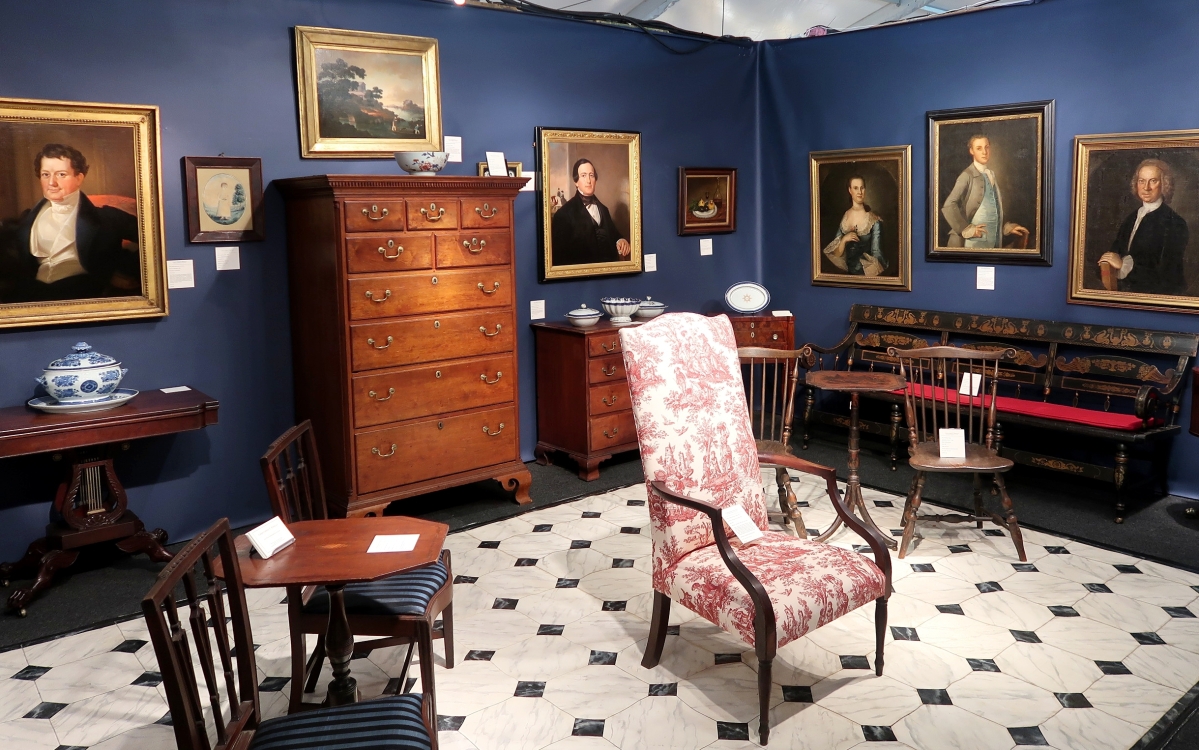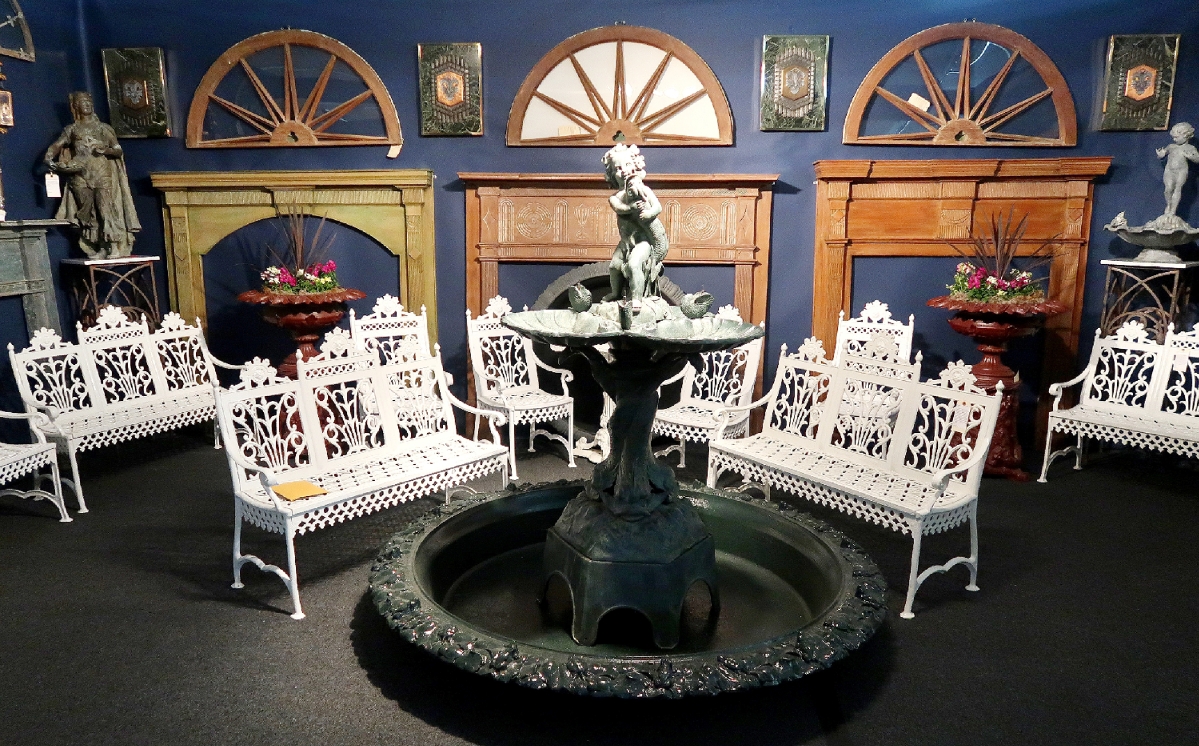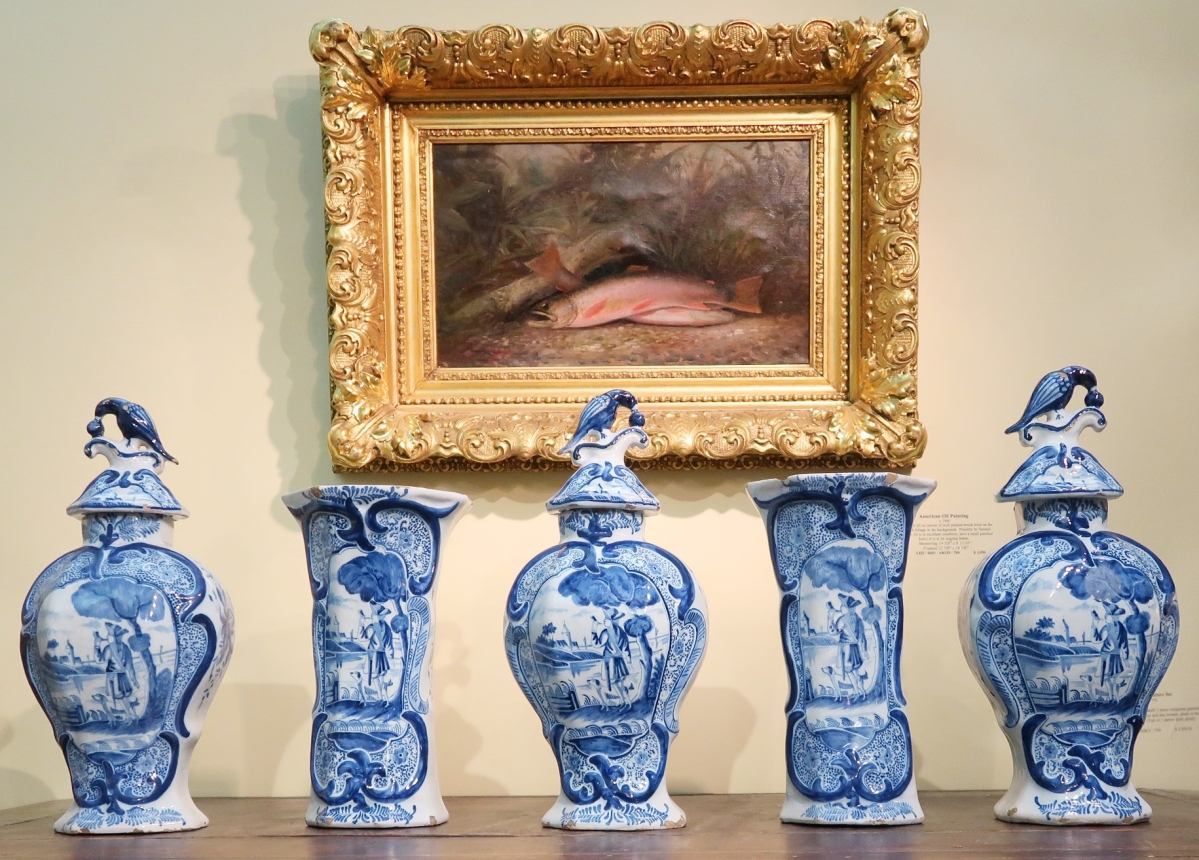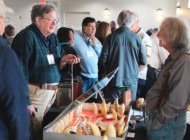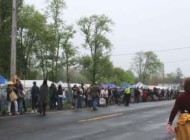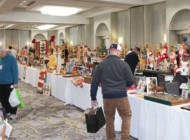Review and Photos by Laura Beach
PHILADELPHIA – At the risk of reaching for a sports analogy, it is hard not to see a parallel between Philadelphia’s beloved – in some quarters, anyway – baseball team, the Phillies, and the Philadelphia Antiques and Art Show. The comparison in part springs to mind because of the show’s Navy Yard setting, a fastball from the Phillies’ home field, Citizens Bank Park, but mainly because of the rebuilding effort that is keeping both organizations vital and competitive.
This year saw a concerted push to continue with the rejuvenation already underway at the Philadelphia show. The April 19-22 presentation completed its third year under the management of Karen and Ralph DiSaia in partnership with Diana Bittel, with Anne Hamilton and Nancy Taylor again serving as the show’s co-chairs. The most significant change has been the Philadelphia Museum of Art’s acquisition of the event from its longtime sponsor, Penn Medicine, the charities sharing some responsibilities and proceeds during the transition. Beyond new sponsorship, which has ramifications for everything from audience to venue, the show is also reaching out to new buyers through diversification of its content and communication strategies.
“This was the most beautiful of the three shows we have been involved with,” Karen DiSaia said after wrapping up. “Exhibitors saved great material and worked very hard on their presentations.” From the benefit preview on Thursday evening through Saturday’s general attendance, the gate was strong, DiSaia said, and sales for many were fair to excellent. DiSaia said she was impressed with turnout for the ancillary programs that ran through the weekend, marveling that interest was as high for the academic lectures as for celebrity Martha Stewart’s Friday afternoon talk on flowers.
The Philadelphia Antiques and Art Show sets up in a purpose-built tent on the Navy Yard’s parade grounds. The tent moved a block or so closer to the water this year. Unexpectedly cold weather and increased winds off the Delaware River made for a chilly preview party. Management resolved the problem the following day and says it will not happen again.
Attempts to broaden the show have not diminished its stature as a prime venue for Americana, especially from Pennsylvania, New York and Maryland. Sales of furniture and folk art appeared to top all else.
“This is how I grew up,” said David Schorsch, who spent his childhood in the Philadelphia suburbs and brought more furniture to Philadelphia than he does to New York’s Winter Antiques Show. David Schorsch-Eileen Smiles ticked off sales of an almshouse painting by Charles C. Hofmann, 1877; a Punch tobacconist figure, possibly from Philadelphia, circa 1880; and an irresistibly petite cherry Chippendale block and shell carved chest of drawers from eastern Connecticut, circa 1790, among other transactions.
“Where some people see falling prices, I see buying opportunities,” Schorsch said.
“It was a very good show, particularly for dealers with pieces from the mid-Atlantic states and the South. I also had a chance to buy on the floor,” said New York dealer Frank Levy, who parted with a Philadelphia Chippendale double-peak camelback sofa of circa 1770, his Thomas Claggett of Newport, R.I., tall case clock and a Philadelphia or Lancaster, Penn., dower chest inlaid with a bird and a star, circa 1750.
Levy’s sofa had been expertly reupholstered to match a scrap of original fabric found pinned to its frame. The dealer’s interest in historic upholstery may be second only to that of Pennsylvania dealer Christopher T. Rebollo, whose display featured a graceful Federal Portsmouth, N.H., or Salem, Mass., lolling chair newly upholstered to reveal its construction, should a studious person be inclined to look. The chair came from the prominent Appleton Farms in Ipswich, Mass.,
“Show was good. Sold 20 things. Like the old days,” Jim Kilvington wrote in an email. The Delaware dealer featured a shapely Queen Anne carved and figured maple side chair by William Savery or Solomon Fussell, Philadelphia, circa 1745-50, along with a pair of Boston or Newport Queen Anne walnut compass-seat chairs of 1730-40.
Charles Clark, the only specialist in Classical American furniture and lighting, sold a pair of ornate side chairs from Salem, Mass., a Philadelphia Classical library chair and bergere in the Gothic taste, and a Regency student lamp stamped Miller & Sons.
“We chose pieces that best represent the span of our inventory,” said English furniture dealer Patrick Bavasi, director of Hyde Park Antiques. Pieces ranged from an early Eighteenth Century small, walnut bureau to an Irish console table and an Anglo Indian padauk wood armchair. Of the latter, which dates to about 1840, Bavasi said, “Sculpturally this piece is a winner and could easily stand alone in any interior.”
“Stone animals rocked! The frigid cold was not an encouragement to garden shoppers but we’re having good follow-up as well as an inquiry about the peacock,” garden antiques specialist Barbara Israel wrote of her Art Deco granite peacock, carved in India around 1930.
Results were robust for a contingent of well-known Pennsylvania dealers. “Best show ever. We sold two of the three spice boxes we brought, plus several pieces of furniture and good paintings, smalls and a Kentucky rifle,” West Chester, Penn., dealer Skip Chalfant said.
“I sold a great piece of redware on opening night and later a Soap Hollow painted stand and a Queen Anne chair,” said Kelly Kinzle, who brought an inlaid Pittsburgh secretary desk, a Philadelphia Chippendale sofa and the sensational paint-decorated lollipop child’s desk that recently surfaced at auction.
Philip Bradley Antiques of Downingtown, Penn., offset tall clocks, lowboys, side chairs and looking glasses with Pennsylvania German works on paper. Initial sales included an English Georgian looking glass, circa 1750; a Philadelphia strapwork side chair, circa 1755; and a group of three York County, Penn., watercolor and ink on paper fraktur.
Carlisle, Penn., dealer James L. Price sold a Queen Anne Massachusetts highboy and, after the show, a Chippendale semi-tall chest, plus smalls, paintings and rugs. “Lots of interest in other pieces,” said Price, anticipating more sales.
Nicolino Calyo, the immigrant artist who depicted Philadelphia’s Schuylkill River and Fairmont Waterworks, was represented by outstanding paintings at Schwarz Gallery and at Diana H. Bittel Antiques.
Olde Hope Antiques was justly proud of a large Jacob Maentel watercolor depicting two full-length figures in a landscape. “It’s the best Maentel to come on the market since the Esmerian sale,” Ed Hild told us.
“We find that colorful objects and unusual smalls really appeal to folks who are looking for less traditional objects that tickle their fancy and brighten their homes,” said Maine dealers Jim and Nancy Glazer, who combined ice fishing decoys with a few choice items from Nancy’s extensive collection of mermaid-themed folk art.
Collectors were abuzz at Stephen and Carol Huber, where an embroidered purse made for Admiral Sir William Penn (1621-1670) was on view. The purse was probably worked in 1660, a year after Penn Sr captured Jamaica. His Quaker son of the same name founded Pennsylvania in 1682. The Hubers first acquired the extraordinary needlework, embroidered with the family’s coat of arms, at Christie’s London in the 1980s at a sale of property collected by Percival Griffiths (1899-1992). “I think we paid 60,000 pounds, over $100,000 at the time,” Stephen Huber said.
Irwin Untermyer (1886-1973), a collector of roughly the same stature and vintage, was associated with the spectacular English looking glass in an embroidered frame, third quarter of the Seventeenth Century, that was a highlight at Grace and Elliott Snyder, South Egremont, Mass.
Needlework specialist M. Finkel & Daughter presented a Boston fishing lady sampler worked by Zebiah Gore. The piece is illustrated in Bolton and Coe’s pioneering 1921 study of American samplers. A nearly identical embroidery worked at the same school belongs to Historic Odessa. Both are dated January 10, 1790. On Sunday afternoon, Philadelphia dealer Amy Finkel sold her catalog piece, a Burlington County, N.J., house sampler by Hannah L. Hancock.
An elaborately embroidered circa 1820 feltwork picture depicting the homestead of the Telfair family of Staunton, Va., hung over a piedmont South Carolina sideboard at Taylor Thistlethwaite. The Southern specialist, who has premises in Virginia and Kentucky, made a series of sales, from a double-sided print of “A View of the Battle Near the City of New Orleans” to a Maryland or Virginia slab table, circa 1800; to a Virginia piedmont walnut book press, circa 1785. Thistlethwaite joined Virginia dealers Sumpter Priddy III and Christopher H. Jones to form a powerful triumvirate of Southern specialists in the show.
The fair boasts depth in American art. William Vareika Fine Arts of Newport, R.I., offered what was the priciest work in the show, the seven-figure “After The Rain Storm” by Frederic Edwin Church, 1875. Pennsylvania Impressionism was at its very best at Avery Galleries, whose large and wintry “Road to the Village” by Edward Redfield, 1908, was unsurpassed. “The Pickup,” a Maine subject by Jamie Wyeth, 2008, was a contemporary classic at Somerville Manning Gallery.
To the delight of shoppers, new exhibitor Paul DeCoste, the nautical antiques specialist from Newbury, Mass., recreated an old-time antiques shop, crammed full of interesting instruments, delft, glass and a huge Bellamy stern board.
Marcy Burns, the show’s only dealer in Native American art, dazzled with exceptional Navajo rugs.
Silver specialists Spencer-Marks sold its catalog piece, a pair of Bailey & Company of Philadelphia coin-silver covered serving dishes. “They are the same design – and possibly the same ones – as shown by Bailey & Co. at the 1853 New York Crystal Palace Exposition, the first World’s Fair held in the United States,” Spencer Gordon said.
“Would you believe we got home Monday night from Philly and are in Virginia for a pewter club meeting where Mel is the guest speaker?” Bette Wolf wrote us after the fair, adding, “Our show was good. We sold to both the advanced collectors and decorators. Had some new buyers for better things. We were delighted to see so many young people attending the show.”
This is only a smattering of what was on offer at the Philadelphia Antiques and Art Show, whose depth and quality make it a mandatory destination for lovers of American fine, decorative and folk art.
As a final note, the Philadelphia Museum of Art has indicated that it will move the show to its premises once the museum completes its American Wing renovations. By then, to return to our sports metaphor, the rebuilding of this important franchise should be complete.
For additional information, www.philadelphiaantiquesandartshow.com.

